Lithuania is situated in Northern Europe and is one of the three Baltic States, alongside Latvia and Estonia. It is situated along the south-eastern shore of the Baltic Sea, to the east of Sweden and Denmark. It is bordered by Latvia to the north, Poland to the south, Belarus to the east and south, and Kaliningrad - a Russian territory - to the southwest.
The terrain of Lithuania is composed of lowlands and highlands and it has a humid, continental climate. Temperatures are relatively mild, although winters can be quite cold.
Lithuania is the largest economy among the Baltic states. Following independence from the Soviet Union, Lithuania underwent rapid reform and transformed from a centrally planned economy to an open market economy. During the late 20th century and early 21st century, Lithuania’s economy expanded and modernised rapidly. The global economic downturn eventually halted this growth and the economy went into recession in 2009. Positive growth rates resumed in 2010, albeit at a slower rate than before.
Important sectors in the Lithuanian economy include information and communications technology food processing, chemical manufacturing, furniture production, agriculture, financial services and tourism. Lithuania’s economy is rated highly inn terms of ease of doing business and economic freedom, and Lithuania is classified as a very high human development country in the Human Development Index. Lithuania is a member of the EU and the Schengen Area, and has been a member of the Eurozone since 2015.


The area now known as Lithuania was inhabited by various Baltic tribes until the first unified Lithuanian state was created in 1253. The Grand Duchy of Lithuania was the largest country in Europe during the 14th century and encompassed present-day Lithuania, Belarus, Ukraine, and parts of Poland and Russia. Lithuania and Poland formed a two-state union in the 16th century, which lasted over two hundred years. It was eventually dismantled and annexed by the Russian Empire.
Lithuania proclaimed its independence in 1918, at the end of the First World War. During the Second World War, Lithuania was occupied by the Soviet Union and then by Nazi Germany. As World War II was drawing to a close, Soviet Union reoccupied Lithuania. In 1990, Lithuania became the first Soviet republic to declare itself independent, resulting in the restoration of an independent State of Lithuania.
Lithuanians have a proud sense of national identity, borne out of the country’s long periods of foreign occupation. Folk music, shared traditions and holidays play an important role in national culture.
Lithuania has a modern road network which connects all cities and town in the country. Inter-city buses provide the most frequent and convenient means of public transportation between towns and cities. Rail travel is another option, but services are limited, while buses and trolleybuses provide public transportation within major towns and cities. Although there are three airports, there are no domestic flights. The largest airport is Vilnius International Airport, with links to cities in Europe, Russia and Turkey.
Both the central and local governments levy taxes in Lithuania, including VAT, income tax, excise tax and profit tax. Social security contributions are also collected separately. Lithuanian companies, companies with a permanent establishment in Lithuania, and non-resident companies are subject to Lithuanian profit tax. The worldwide income of Lithuanian companies is taxable, but deductions can be made in accordance with double taxation treaties. In other cases, income attributable to business in Lithuania is taxable. Most companies are taxed at a low rate of 15%, while interest and royalty income paid to non-resident companies is taxed at a rate of 10%. A rate of 5% applies on the profits of agricultural enterprises and small companies.